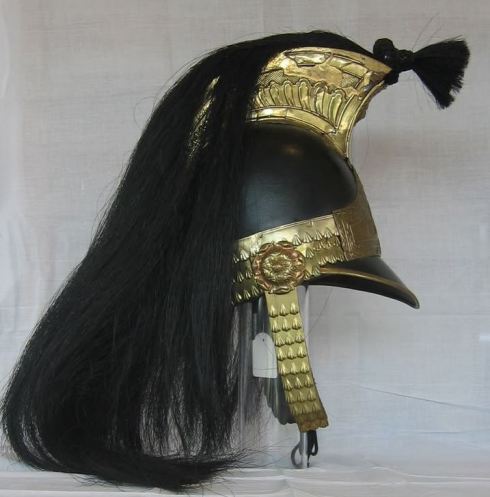 Apologies for my recent neglect of this blog, but here’s an uncommon button with the rose of Lancashire, inscribed “Furness Curassiers[sic]”, from a yeomanry troop that went in for a bit of post-war glamour. Neighbouring Cheshire may have boasted the Adlington Lancers among its yeomanry of the ‘twenties, but Lancashire went in for a proper piece of armour. The late R J Smith’s 1983 Ogilby Trust booklet on the Duke of Lancaster’s Own Yeomanry narrates the formation of Captain Thomas Braddyll’s Furness Troop in 1819, noting that it was also known as the Furness Cuirassiers, and continues:
Apologies for my recent neglect of this blog, but here’s an uncommon button with the rose of Lancashire, inscribed “Furness Curassiers[sic]”, from a yeomanry troop that went in for a bit of post-war glamour. Neighbouring Cheshire may have boasted the Adlington Lancers among its yeomanry of the ‘twenties, but Lancashire went in for a proper piece of armour. The late R J Smith’s 1983 Ogilby Trust booklet on the Duke of Lancaster’s Own Yeomanry narrates the formation of Captain Thomas Braddyll’s Furness Troop in 1819, noting that it was also known as the Furness Cuirassiers, and continues:
“There has been considerable doubt expressed as to whether the Furness Troop ever wore cuirasses, and it must be stated that no positive evidence has yet come to light, but it will be seen that available evidence tends to prove that the Troop were Cuirassiers in fact as well as in name. Major J E Willan of Silverdale wrote in the Yeomanry Record of October 1898 saying many years ago a Troop of Yeomanry raised in the Furness district wore the cuirass, and bright steel helmets with an enormous bearskin crest projecting in front … He had talked with old men who could remember seeing the Yeomanry crossing the Sands, going to and from Lancaster with their armour flashing in the sun.”

Photo Stuart Bates
It’s a rather wonderful image. No attributed cuirass seems to have survived, but helmets of the Cuirassiers are known. In 1999 Bosley’s offered a complete example, which seems to have been that described in Crown Imperial of 1982 as quoted by Smith. It is of the 1812 to 1818 Heavy Dragoon pattern, with a blackened metal skull, gilt furniture and a black horsehair mane and short plume. The original front plate carries an oval plaque inscribed “Furness Yeomanry”, concealing the title of the original unit. (Smith describes the sides of the skull as decorated with metal leaves, but there is no sign of this in this photo, and this may be a reference in error to the laurel leaves ornamenting the edges of the front plate.) The example here is owned by Stuart Bates, and the image used with his kind permission.
Smith describes two other dilapidated examples, one now lost and one with a skull and peak of blackened leather. Evidently Captain Braddyll acquired a mixed lot of these redundant helmets on their retirement from regular service in 1818.
In 1828 the Lancashire independent troops, the Cuirassiers included, were amalgamated as the Lancashire regiment, the dress of the Furness troop was “assimilated” with that of Wigan, and the breast and backplates of the Cuirassiers flickered only in the sunlight of memory.
